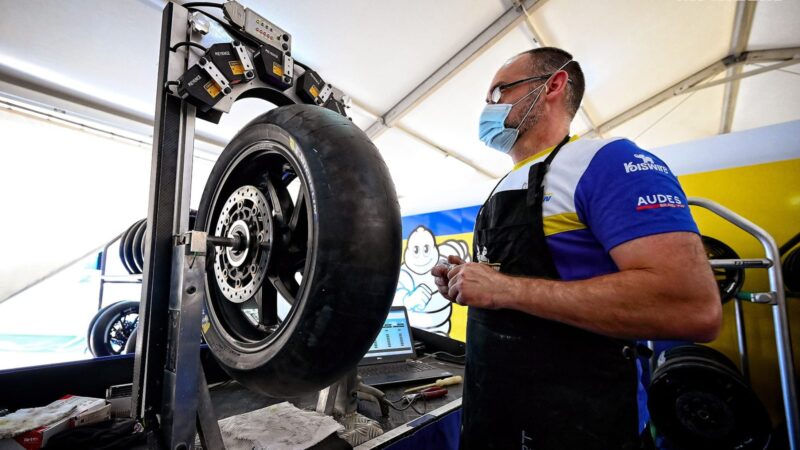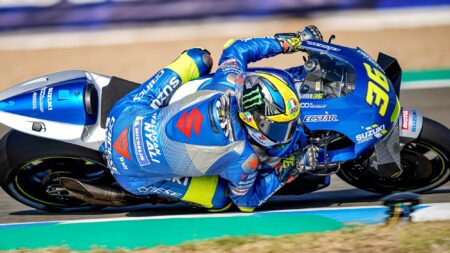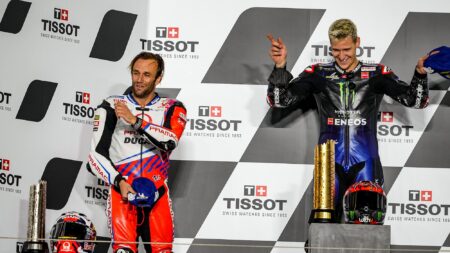There are two other factors at play here.
Today’s fastest MotoGP bikes make around 300 horsepower – no tyre is going to survive 40 minutes of full gas from that kind of engine.
Michelin spec tyres were introduced alongside Magneti Marelli spec software, purposefully designed to be much less clever than the tailormade software developed by the factories during the previous decade or so. That factory kit automatically adjusted traction control, torque delivery and so on according to tyre wear and changing grip conditions, to help conserve the rear tyre.
The spec software does none of that, so it’s up to the rider to use his brain and his right wrist to do that job.
I’ve little doubt that the fans who complain about riders needing to look after the tyres are the same fans that complained about hi-tech factory software taking the skill out of riding.
And what about the theory that Michelin designs its tyres to degrade early to make the racing more exciting? It’s possible, but Michelin HATES the fact that it has yet to break every Bridgestone race record. After five seasons of Michelin MotoGP tyres seven race records are still held by Bridgestone: Aragon, Assen, Brno, COTA, Motegi, Phillip Island and Termas.
Michelin hopes that some of those records will go this year, because its 2021 range of tyres are slightly harder, for better race-long performance.
Why does Michelin use reheated tyres?
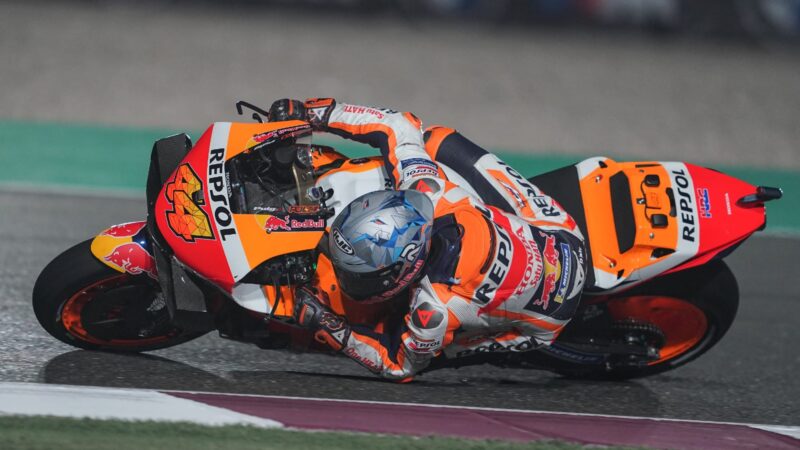
Pol Espargaró and the other three Honda riders struggled with front tyres in Qatar
Honda
In Qatar there was much talk of the effect of reheated and reused tyres. Riders have been reheating and reusing tyres forever – because the only alternative is to throw them away before they’re finished, which would be madness.
So are reheated/reused tyres a problem in MotoGP?
“You get a small performance drop if a tyre is reheated from the previous day,” one crew chief told me. “But these tyres are still good enough to assess settings changes – electronics, suspension and so on – in testing and free practice.”
Reheated tyres are distributed evenly among riders and marked accordingly, so teams make sure they’re only used when the rider isn’t racing or chasing absolute lap times.
What about all the front-end crashes?
Michelin’s rear slick is better than its front slick, just as Bridgestone’s front slick was better than its rear slick. Therefore the vast majority of MotoGP crashes are caused by the rider losing the front in corner entry. In the Bridgestone spec era the most common accident was a corner-entry highside.
“I’d much prefer the situation where riders are losing the front, in which the rider is only falling half a metre and then the centrifugal force tends to carry the rider out of the danger area,” said another engineer. “During part of the Bridgestone era a lot of riders were getting highsided from the rear, which is never nice. In this sense the Michelins are definitely friendlier than the Bridgestones.”
Is spec-tyre racing a good or a bad thing?
Some fans pine for the days of open-tyre competition. The fact is that no system is perfect. There are positives and negatives to both.
The negative of spec tyres is that riders and factories must adjust their techniques and engineering to suit the tyres. But even old-school engineers like Jeremy Burgess preferred spec tyres, because they forced him to work on the bike, rather than band-aid a problem with a special tyre.
“With spec tyres it’s the same for everyone and whoever develops the bike to maximise tyre performance comes out on top,” said JB in 2009, MotoGP first year of spec tyres.
And then there were the overnight specials, designed to dovetail with data gathered on Friday, manufactured on Saturday and flown or driven to the circuit for race day. For favoured riders only.
And that wasn’t the worst of it. Back in the days of open tyre competition the companies had different grade tyres for different grade riders, so what chance did an up-and-coming rider have when he had lower-grade tyres?
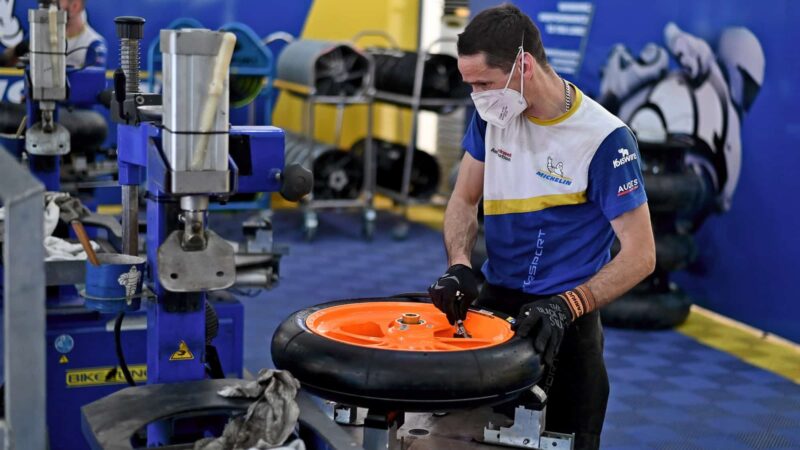
Fitting a front slick to a Repsol Honda rim at Losail
Michelin
World Superbike rider Chaz Davies tells a story from his 250 GP days that perfectly illustrates this problem.
“I remember visiting the Dunlop truck on a Thursday afternoon to have a look at my tyre list for the weekend,” says Davies. “My list was always really simple: a couple of different tyre numbers for the front and couple for the rear. That’s your lot. This time they gave me this tyre list which was more like a book: five different fronts, seven rears… I stared at it for a bit and then the Dunlop guys snatched it back off me.
“They’d shown me [Andrea] Dovizioso’s tyre sheet by mistake. That’s what you were up against – if you paid for the better bike you got better tyres too.”
What’s the deal with the new asymmetric front?
Asymmetric MotoGP tyres have been part of the game since the 1990s. Some circuits demand much more from one side of the tyre than the other, so it makes sense to use a harder compound on one side and softer rubber on the other.
Asymmetric fronts are a more recent innovation. Front tyres are more complicated, because the rider needs perfect feel from the front to attack corners and if the tyre slides there’s not much chance saving it, so it’s important that front tyres give no nasty surprises.
This year, Michelin is allocating more asymmetric fronts. The medium front in the Qatar/Doha GPs allocation was asymmetric, but it proved very unpopular. Over the two weekends only four riders chose the tyre for one race, the second Doha round, and they were the four KTM riders.
Many riders suffered crashes with the asymmetric, because then there was too big a difference between the softer rubber on the left and centre of the tyre and the hard rubber on the right.
KTM and Honda riders were the real victims, because the RC16 and RC213V are built to make time and make passes during braking and corner entry, so they need a tough front tyre. At Losail the RC16 and RC213V destroyed the soft tyre and couldn’t race with the hard tyre, which was only in the allocation for the much, much hotter daytime practice sessions.
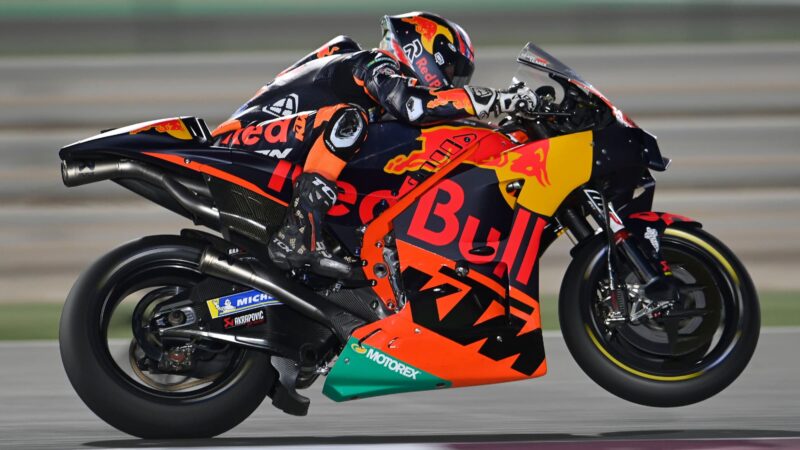
Binder risked the asymmetric front for race 2 in Qatar and reaped the reward
Red Bull
“Three-quarters of the tyre is the (softer) K compound and the last quarter on the right is the (harder) H compound,” explained LCR Honda rider Álex Márquez. “There is a lot of difference between the K and the H, so when you go into a right corner and move to the harder compound you lose the front. So your riding style needs to change a lot from lefts to rights, so this tyre isn’t nice to ride.”
Brad Binder also suffered several crashes with the asymmetric front. But after destroying the soft front before half-distance in the Qatar GP he decided to use the tyre for the Doha GP. His second race time was 13.7 seconds better than the first – an improvement of six tenths per lap – and he finished eighth, instead of 14th.
“The main difference between the two races was that the asymmetric front tyre lasted to the end, so I was able to push all through the race, whereas last Sunday, with nine laps to go, I was a passenger on the bike, just trying to get home.
